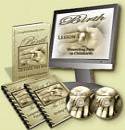Natural Labor Pain management
Sources of Discomfort | Labor Pain Management Techniques
A wide variety of natural labor pain management techniques may be used to ensure a smoother birth experience. It's quite common to use different methods throughout the different stages of birth. There is no one-size-fits-all approach. The most effective strategy is to listen to one's body - preferences will change throughout labor - be open to new ideas.
Expectant women often ask veteran mothers, "How painful is childbirth?" The true answer to this question is that most pain in labor is extrinsically created and preventable. It is crucial to first address unnecessary sources of discomfort in labor which include anxiety, inadequate nutrition, and ineffective body positioning. Eliminating these factors will lead to a smoother, more comfortable birth experience.
The most critical labor pain management technique is relaxation - mental, physical and emotional. Relaxation is the foundation of a comfortable natural birth. For more information on specific relaxation techniques for labor, see the Relaxation Techniques section.
Throughout birthing, it's normal for women to rotate between favorite labor pain management techniques. A woman may initially find comfort in the water, only to find that once transition begins, her body desires to be on dry land. After a few minutes, she may again desire to be back in the water to birth her baby. As labour progresses, the body and the baby's position constantly evolve to create the optimal conditions for birth. As a result, the need for different forms of labor pain management evolves simultaneously.
Dealing with Discomfort
Since the sources of discomfort can be interrelated, effectively maintaining a high level of comfort in birth requires addressing all three factors. Once they have been properly addressed, any residual discomfort in labor will be greatly minimized and can be addressed with any of the following labor pain management techniques:
- Counter Pressure
- Environmental
Conditions
- Breathing Techniques
- Water
- Birthing
Aids
- Vocalization
- Visualization
- Emotional Support
Counter Pressure
Counter pressure is an effective labor pain management strategy for back labor or other area-specific discomfort. It is performed by applying pressure, usually significant pressure, to an area of discomfort, such as the small of the back. Back labor can also be a sign of an occiput-posterior baby, or one that is facing the mother's abdomen rather than her spine. With this type of presentation, the baby's face may be pressed against the mother's pelvic bones, causing discomfort for both mother and baby. The head isn't able to flex properly to allow the smallest diameter to pass through the birth path. In this case, techniques such as lunges or the lift technique, may help the baby rotate into an optimal birthing position.
Environmental Conditions
Birth affects, and is affected by, every sense in the body. By giving special attention to all the senses, we can bring harmony to the mother as a whole. Labor pain management techniques should address all the senses. For the visual sense, try dimming the lights or using candles to bring a soft glow to the birth environment. For the sense of smell, use aromatherapy, scented candles, or essential oils to bring calming, soothing scents. For the auditory channel, speak in low, soothing tones. Refrain from unnecessary chatter or extraneous background noise. Relaxation music, such as that used for relaxation practice during the pregnancy, can be softly played. For the tactile sense, use counter-pressure, massage, or light touch massage, as the mother wishes. Bring soft towels, blankets or pillows to avoid rough textures.
Breathing Techniques
Breathing techniques, such as sleep/rhythmic breathing, can center birthing women and focus their mental state. Sleep breathing is performed by filling the abdomen first, rather than the lungs. The mother is to inhale for a count of 4, then exhale to a count of 8. She should focus on making her abdomen rise and fall, rather than collapsing her lungs or using shallow clavicular breathing. This type of breathing is similar to the pattern used during sleep, hence, the name.
Breathing can also be used as a force to expel the baby. Women can actually "breathe" their babies down the birth path by sending breath down through their body. An excellent visualization to pair with this type of breathing is to envision the body as a "J" with the breath following that shape down and out the birth path. Instead of blowing the air out of the mouth, think instead of directing it downward. An excellent way to monitor whether this type of breathing is being done correctly is to place one hand on top of the belly, right beneath the bust. This area at the top of the belly should tighten as the breath is expelled. Another advantage of this breathing technique is that it allows the perineum to stay relaxed while the baby is descending, thus reducing the risk of tearing and allowing a smoother, shorter pushing stage, or eliminating it entirely.
Water
The use of water is well-documented as a labor pain management technique. Laboring women can get in the shower and direct the water stream to specific areas of discomfort. Using a labor tub decreases the pressure on the mother's body, alleviating pressure and making her more buoyant. This can enhance her relaxation and facilitate comfortable birthing positions. Complete submersion is not always encouraged in early labor as the water may lessen the concentration of oxytocin in the mother's body, thus slowing labor. See the Waterbirth section for detailed information.
Birthing Aids
A wide variety of common household items and some commercially-available tools can be used for labor pain management. For a hospital birth, women can request the use of a birthing ball, childbirth squat bar or kneeler to help with appropriate positioning. For detailed instructions on the importance of using effective positioning in labor, please refer to the full Birth Positions section.
Vocalization
Voice is a powerful tool. A birthing woman may choose to moan with her contractions. She may choose to softly sing, chant, or grunt. She needs to follow her body and know that whatever sounds she makes are good sounds, are natural sounds. There are no apologies here; she must follow her body's lead throughout the process of birthing.
Visualization
Mental imagery is a highly-effective labor pain management technique, used frequently by professional athletes to naturally enhance their performance. A mother can use the same technique to visual herself in each of the stages of birth - how she will respond to the different changes and challenges she may face. When we visualize a sequence of events as we would like them to happen, we mentally prepare ourselves to act in that situation. This reduces anxiety of the unknown in that the scene has become a familiar one, not a scary new experience. Laboring women may visualize their cervix opening, their baby descending the birth path, or their breath as it enters and exits the body. These techniques are particularly effective when paired with a imagery relaxation script, either read by a birth companion or in audio form.
Emotional Support
Next to relaxation, emotional support may be the most critical, and most overlooked, natural labor pain management technique for all labouring women. Studies have shown that women supported by other women, including a doula, or knowledgeable birthing companions, experience more positive, less complicated births and report more satisfaction with their birth experiences. They also show less use of interventions during birthing and faster recovery.
When a woman is laboring, she may need someone to be her voice. When she becomes immersed in her work, the work of birthing her child, she may depend on others to monitor her needs - is her jaw clenched or her eyes shut tight, does she need to alter her position, is she breathing effectively - and suggest comfort measures along the journey.
She needs someone to lean on, both physically and mentally. Just the simple fact of knowing that she is surrounded by those people with genuine concern for her well-being and that of her baby, can put her mind at ease and allow her to focus on the task at hand.
Most critical of all, women need to be reminded that not only can they give birth naturally, but that they are giving birth naturally. That each surge of a contraction is bringing them closer to their child, that each breath brings them closer to motherhood, when the real worries begin!
References
Royal College of Midwives. 2006. "Immersion in water during labour and birth." Joint Position Paper no. 1. London, Royal College of Obstetricians and Gynecologists and Royal College of Midwives.
Ros, Andrea, Ricardo Felberbaum, Iris Jahnke, Klaus Diedrich, Peter Schmucker, and Michael Huppe. 2007 "Epidural anaesthesia for labour: does it influence the mode of delivery?" In Archives of Gynecology and Obstetrics. V. 275(4):269-274(6).
Cluett E R, Nikodem VC, McCandlish RE, Burns EE. Immersion in water in pregnancy, labour and birth. Cochrane Database of Systematic Reviews 2002, Issue 2. Art. No.: CD000111. DOI: 10.1002/14651858.CD000111.pub2.
Geissbühler V, Eberhard J: Waterbirths: A Comparative Study. Fetal Diagn Ther 2000;15:291-300 (DOI: 10.1159/000021024)
Smith CA, Collins CT, Cyna AM, Crowther CA. Complementary and alternative therapies for pain management in labour. Cochrane Database of Systematic Reviews 2006, Issue 4. Art. No.: CD003521. DOI: 10.1002/14651858.CD003521.pub2.
Lowe NK. The nature of labor pain. Am J Obstet Gynecol 2002;186(Suppl 5):S16-24.
Lowe NK. Differences in first and second stage labor pain between nulliparous and multiparous women. J Psychosom Obstet Gynecol 1992;13:243-53.
Return from Natural Labor Pain Management to Giving Birth Naturally Home
Page Last Modified by Catherine Beier, MS, CBE
Most Popular
How to Use Acupressure to Induce Labor
Childbirth Relaxation Script MP3s
Nutrition During Pregnancy - Nix the Notion of Eating for Two
Looking for a Birth Professional? Search our Provider Directory
Online Childbirth Classes
Choose 7 week, 12 week, or Self- Paced online childbirth classes available wherever and whenever you need them.
Featured Birth Story
Vanessa's natural birth story shows that when birth is left alone to proceed as it should, it waits for no one - not even doctors or midwives.
Free Pregnancy Tickers
Create a free pregnancy ticker to post on your blog, website, Facebook profile or favorite social media...




